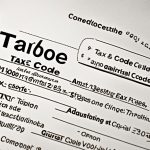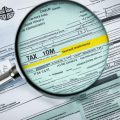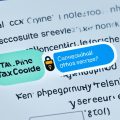For the tax year 2024/25, understanding the LX tax code is crucial for anyone navigating the UK tax system. Assigned by HM Revenue & Customs (HMRC), the LX tax code indicates that your correct tax code is not yet known. It typically signifies that your tax-free allowance is being reduced due to certain circumstances, such as the collection of underpaid tax from a previous year or other adjustments.
This temporary code can be assigned for various reasons, such as changing jobs without a P45, transitioning from self-employment to employment, starting your first job, or receiving company benefits or the state pension. Knowing what this code signifies, how it affects your income, and its implications can help you manage your finances more effectively. This article will delve into the details of the LX Tax Code, including examples and tables to illustrate how it works.
What is the LX Tax Code?

The LX Tax Code is a unique tax code used by HM Revenue & Customs (HMRC) to adjust your personal allowance and ensure you pay the correct amount of tax. It typically indicates that your tax-free allowance is being reduced due to certain circumstances, such as the collection of underpaid tax from a previous year, adjustments for benefits in kind, or other income-related factors.
This reduction means that a larger portion of your income will be subject to taxation, potentially leading to higher tax deductions each pay period. Understanding the LX Tax Code is essential to managing your finances, as it directly impacts how much of your income is taken as tax before you even receive it.
How the LX Tax Code Works?

The LX Tax Code works by modifying your standard personal allowance, which is the amount of income you can earn before paying tax. For the tax year 2024/25, the standard personal allowance is £12,570. However, if you are on an LX Tax Code, this amount may be reduced based on specific circumstances, such as outstanding tax liabilities or adjustments for additional benefits.
This reduction means that the portion of your income that is tax-free is decreased, resulting in a higher taxable income. Consequently, you will see a higher amount of tax deducted from your earnings each pay period, which reflects the adjustments applied to ensure accurate tax collection.
Example
Imagine you have underpaid tax by £500 in the previous tax year, and HMRC decides to collect this amount through your tax code. If your standard personal allowance is £12,570, HMRC might reduce this by £500, leaving you with an adjusted personal allowance of £12,070. The LX Tax Code will reflect this change.
Table: LX Tax Code and Adjusted Personal Allowance
| Scenario | Standard Personal Allowance (2024/25) | Adjustment | Adjusted Personal Allowance |
|---|---|---|---|
| No adjustments (Normal code) | £12,570 | £0 | £12,570 |
| Underpayment of £500 collected | £12,570 | -£500 | £12,070 |
| Underpayment of £1,000 collected | £12,570 | -£1,000 | £11,570 |
As seen in the table, the LX Tax Code results in a lower personal allowance, meaning you will pay more tax than you would with the standard personal allowance.
Why Might You Receive an LX Tax Code?

There are several reasons HMRC might assign you the LX Tax Code, including:
1. Underpayment of Tax: If you have underpaid tax in a previous year, HMRC may adjust your tax code to collect the outstanding amount.
2. Benefit in Kind: If you receive benefits from your employer, such as a company car or medical insurance, this could reduce your personal allowance.
3. Other Adjustments: This might include adjustments for other types of income or changes in your circumstances, such as starting a new job or receiving additional income that wasn’t taxed at source.
How to Check and Understand Your LX Tax Code?

To ensure you are paying the correct amount of tax, it’s essential to regularly check your tax code. The LX Tax Code, assigned by HM Revenue & Customs (HMRC), typically indicates that your tax-free allowance is being adjusted due to circumstances such as underpayment or additional benefits. For the tax year 2024/25, the standard personal allowance is £12,570, but this may be reduced with an LX Tax Code.
Example Payslip Breakdown
| Description | Amount |
|---|---|
| Gross Salary | £30,000 |
| Personal Allowance (Adjusted) | £12,070 |
| Taxable Income | £17,930 |
| Income Tax (20%) | £3,586 |
In this example, the taxable income is calculated after deducting the adjusted personal allowance of £12,070 from the gross salary. The tax is then calculated at the standard rate of 20% for basic rate taxpayers.
Here’s how you can check and understand your tax code:
1. Check Your Tax Code
1. Review Your Payslip: Your tax code is displayed here.
2. Check Your PAYE Coding Notice (P2): This notice provides details about your tax code for the upcoming tax year.
3. Refer to Your P45: If you’ve recently changed jobs, your P45 will indicate your tax code.
4. Consult Your P60: This document shows your tax code and summarizes your earnings and deductions.
5. Look at Your Pension Advice Slip: If you receive a state pension, your tax code will be mentioned.
6. Create an Account on the HMRC Website: Register online to access your tax code information.
7. Contact HMRC Directly: Call HMRC at 0300 200 3300 if you need further assistance.
2. Request a Tax Code Change
Contact HMRC: Call HMRC’s helpline or use their online services if you believe your tax code is incorrect.
Provide Necessary Information: Be ready to provide relevant details or documentation to support your request for a tax code change.
By reaching out to HMRC and requesting a tax code change, you can ensure that your tax obligations align with your current circumstances, avoiding any potential issues such as overpaying or underpaying taxes.
3. Ensure Tax Code Accuracy
It is crucial to regularly check and update your tax code to prevent any discrepancies in the amount of tax deducted from your income. By making sure your tax code accurately reflects your situation, you can avoid unnecessary tax complications.
| Tax Code | Abbreviation | Meaning |
|---|---|---|
| 1250L Tax Code | L | Standard tax code for most individuals. |
| BR Tax Code | BR | All income taxed at the basic rate, usually for a second job or pension. |
| NT Tax Code | NT | No tax deducted from income. |
By following these steps, you can take control of your tax code and ensure that your taxes are accurate and up to date.
What Should You Do If You Have an LX Tax Code?
If you receive an LX Tax Code, it’s advisable to:
1. Check the Adjustments: Ensure that the adjustments made to your tax code are accurate. If you believe there is a mistake, contact HMRC to clarify.
2. Plan Your Finances: Since the LX Tax Code may result in higher tax deductions, it’s important to plan your finances accordingly. Understanding how much more you’ll pay can help you manage your budget.
3. Seek Professional Advice: If you’re unsure about your tax situation, consulting with a tax advisor or accountant can provide valuable guidance and ensure you’re not overpaying or underpaying tax.
Understanding Different Tax Codes
In the UK, tax codes play a crucial role in determining an individual’s tax obligations. These codes consist of a combination of numbers and letters, each representing specific aspects of their tax calculation:
Tax Code Basics
- The numbers in a tax code represent the tax-free income allowance an individual is entitled to.
- The letters in a tax code provide additional information about how the individual’s pay should be taxed.
Now, let’s explore some common tax code letters and their meanings:
| Tax Code Letters | Meaning |
|---|---|
| L | Standard personal allowance |
| M/N | Marriage allowance |
| T | Special calculations |
| BR/D0/D1 | Different tax rates |
| NT | No tax deducted |
| K | Adjustments to personal allowance |
Here are a few examples of tax codes:
| Tax Code Examples | Meaning |
|---|---|
| 1257L | Standard tax code |
| BR | All income taxed at the basic rate |
| S1250L | Scotland tax rates |
Understanding these different tax codes is essential to ensure accurate tax calculations and compliance with HMRC regulations.
Consequences of Incorrect Tax Codes for Small Businesses
Small businesses can face significant consequences due to incorrect tax codes. When tax codes are inaccurate, it can lead to overpaying or underpaying taxes, which can potentially result in legal issues and penalties. It is crucial for employers to assign the correct tax codes to their employees, ensuring compliance with HMRC’s requirements.
Navigating the complexities of UK tax codes can be challenging for small businesses. It’s important to remember that mistakes can happen, especially when dealing with ever-changing tax regulations. However, there are tools and software available, such as CharlieHR, that can simplify tax code management and help ensure accuracy and compliance.
Using reliable tax code management tools allows small businesses to streamline their tax processes, reducing the risk of errors and penalties. These tools often have intuitive interfaces and features that make it easier to track and update tax codes for employees.
By adopting efficient tax code management practices, small businesses can avoid the negative consequences of incorrect tax codes. Ensuring that tax codes are accurate and up-to-date not only protects the business from potential legal issues, but also helps to maintain a healthy financial standing.
Tax Code Challenges for Small Businesses
Small businesses face unique challenges when it comes to managing tax codes. The sheer number of tax codes available, each with their own specific rules and calculations, can be overwhelming for business owners and HR professionals.
Add to that the fact that tax codes can change annually or in response to individual circumstances, and it becomes even more challenging to stay up-to-date. Keeping track of changes to tax codes and ensuring that employees’ tax codes are adjusted accordingly requires considerable time and effort.
Moreover, small businesses often have limited resources dedicated to tax management. They may not have dedicated HR departments or in-house accountants to handle tax code intricacies. This increases the risk of errors and can put the business at a disadvantage.
Fortunately, technology solutions like CharlieHR can help small businesses overcome these tax code challenges. These platforms provide user-friendly interfaces, automate tax code updates, and offer resources and support to ensure accurate compliance with tax regulations.
Benefits of Effective Tax Code Management

Implementing effective tax code management practices brings several benefits for small businesses. Here are some key advantages:
- Accurate tax calculations: By ensuring that tax codes are correct and up-to-date, businesses can avoid overpaying or underpaying taxes, leading to improved financial control.
- Compliance with tax regulations: Correct tax code management helps businesses meet HMRC’s requirements, minimizing the risk of penalties and legal issues.
- Time and resource savings: Automation and simplification of tax code processes save valuable time and reduce the burden of tax management on small businesses.
- Improved employee satisfaction: Accurate tax codes contribute to reliable payroll calculations, ensuring employees are paid correctly and on time.
Conclusion
The LX Tax Code for the tax year 2024/25 plays a crucial role in ensuring that you pay the correct amount of tax by adjusting your personal allowance. Whether due to underpaid tax from previous years or other adjustments, understanding how this tax code works can help you stay on top of your finances. Always check your tax code notice and seek advice if you have any concerns.
Regularly checking your tax codes is crucial to ensure accuracy and compliance with HMRC’s requirements. If you discover any errors or discrepancies, don’t hesitate to make the necessary changes. By effectively managing your tax codes, you can simplify your tax processes and avoid costly mistakes.




















No Comments
Leave a comment Cancel